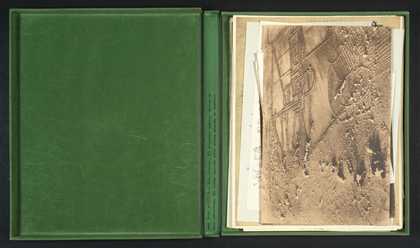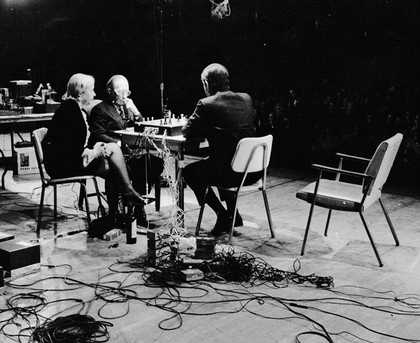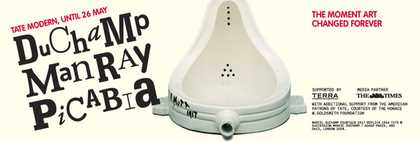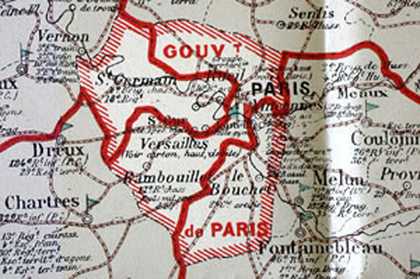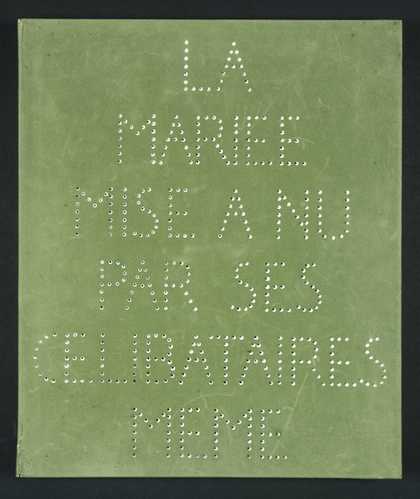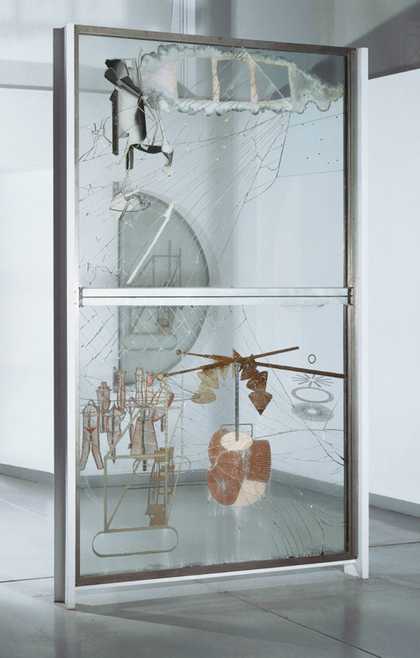
Fig.1
Marcel Duchamp
The Bride Stripped Bare by her Bachelors, Even (The Large Glass) 1915–23
Oil, varnish, lead foil, lead wire, and dust on two glass panels
Bequest of Katherine S. Dreier 1952
Philadelphia Museum of Art
Entirely original in the ideas it expresses and its materials, Marcel Duchamp’s The Bride Stripped Bare by her Bachelors, Even (The Large Glass), 1915–23 (Philadelphia Museum of Art, fig.1) is a landmark in the history of twentieth-century art. In it Duchamp abandoned canvas for glass, oil paint for lead wire, and visual coherence for what is, in effect, a patchwork of enigmatic motifs. In ways that had few, if any, precedents in art, the imagery of the Large Glass was influenced by photography and by chance; traditional perspective was explored and the idea of a fourth dimension toyed with. As revealed much later through the artist’s notes and diagrams, the narrative told by the work centred on a circulation of gas, liquid and light energy around the realms of the Bride (top panel) and her Bachelors (bottom panel), in forms and processes more usually associated with physics and mechanical engineering than art. This bizarre merry-go-round of mechanistic causes and effects represented a curiously denatured and desexualised vision – in turns, humorous and cynical, poetic and imaginative – of the workings of sexual attraction and desire in men and women.
In this very tall, two-part work, Duchamp set himself the challenge of not only creating ‘something that had not been previously attempted’ but also something that mirrored his mind.1 He said: ‘My research was in the direction of finding some way of expressing myself without being a painter, without being a writer, without taking one of these labels, and yet produce something that would be an inner product of myself.’2 But the Large Glass was more than an intensely individual statement. Based on a ‘wedding of mental and visual reactions’ and ‘an accumulation of ideas’,3 it prioritised the conceptual over the visual – or, to use Duchamp’s often repeated terms, the ‘gray matter’ over the ‘retinal’ – to such an extent that it signalled a new understanding of the role of art. The actual work was inimitable but the thinking behind it constituted a crucial milestone in the subsequent development of conceptual art.
However, it took many years for the significance of the Large Glass to be widely appreciated. Duchamp worked on the two glass panes in his studio in New York from 1915, until, bored by the slow and tedious work involved in realising the piece, he declared his masterwork ‘definitively unfinished’ in 1923. His friends and patrons were, of course, aware of the Large Glass and its general themes, but the work was not discussed publicly. It was exhibited only once in the interwar years, in the Brooklyn Museum in 1926; and, curiously for a work in which ideas derived from photography had played an important role, Duchamp did not bother to have it photographed.4 Smashed while in transit, the work lay in pieces in a crate from 1926 until Duchamp was able to return to America to repair it in 1936, and thereafter the work remained in a private collection until given to the Philadelphia Museum of Art in 1952. A turning point in the reception of the Large Glass, however, came with Duchamp’s decision in the early 1930s to publish notes and diagrams relating to the work’s iconography that he had written chiefly in Paris between 1912 and 1915 (he began work on the panes of glass themselves only when he moved to New York in mid 1915).
The notes and drawings
The notes associated with the Large Glass have assumed an importance that has few parallels in the oeuvres of other modern artists. This is all the more surprising as most of the notes were just jottings on small scraps of paper, complete with crossings-outs and afterthoughts. Duchamp later said of the notes: ‘Whatever idea came to me, I would put it on a piece of paper, any piece of paper, so those papers have all kinds of shapes, torn shapes. They are general, without any destination to speak of, just an idea that comes to you when you dream a bit or read and I put them down for eventual use if necessary.’5
Unpolished, spontaneous, personal: the notes seem to offer a direct route into Duchamp’s thinking and into the genesis of the various ideas that led to the creation of the Large Glass. Yet, as was revealed only with the posthumous publication of some notes by his stepson Paul Matisse in 1980, Duchamp had developed from the beginning a particular vision for the notes themselves and a specific style of writing. One early note published in 1980 revealed that he consciously aimed to write in a formal fashion, as in a business letter, and to present his ideas as if they were logical proofs, using conventional formulae, geometrical theorems and repeating statements to give them the weight of axioms: ‘Give the text the style of a proof by connecting / the decisions taken by conventional formulae of / inductive reasoning in some cases, deductive in others. / Each decision or event in the picture becomes either / an axiom or else a necessary conclusion, according to a / logic of appearance.’ He also wrote: ‘Avoid all formal lyricism; let the text be a /catalogue –.’, which explains why there is so little by way of developed narrative or explanation in the notes.6 From the beginning, then, it would seem that Duchamp envisaged the notes as a particular form of writing, one that was stylised, even depersonalised, and destined for some form of publication.
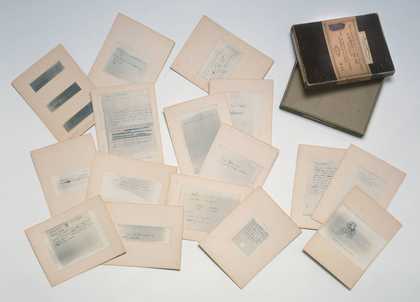
Fig.2
Marcel Duchamp
The Box of 1914 1914
Photographic facsimiles of 16 manuscript notes and the drawing To Have the Apprentice in the Sun, 1914, mounted on matboards, each c.24 x 18cm, contained in a commercial photographic supply box. Edition of 5.
Philadelphia Museum of Art. The Louise and Walter Arensberg Collection © Succession Marcel Duchamp/ADAGP, Paris and DACS, London
Duchamp first published some notes in 1914, producing a hand-made edition of five small boxes (The Box of 1914) containing sixteen notes and one drawing, each reproduced photographically and mounted onto board (fig.2). There was no market as such for these boxes, nor did he aim to make the boxes and their contents widely known. He gave three of the boxes as presents to his brother and close friends, and offered another box containing the original notes to his patron Walter Arensberg. Although the notes were prepared while Duchamp was thinking about the Large Glass, they reveal almost nothing about his great project; they do not even mention the words ‘Bride’ and ‘Bachelors’. Instead, they offer elusive word plays and short comments about materials and art that read as cryptic memos to himself (for example, ‘One can look at [see] seeing; / one can’t hear hearing.’ and ‘Make a painting/ of frequency:’).7 Given that Duchamp had in his possession a whole raft of notes that set out the narrative of sexual attraction he was developing in the Large Glass, this decision not to reveal anything of the meaning of his magnum opus in the Box or, for example, in later interviews, was clearly intentional.
His position changed in the early 1930s. According to Duchamp himself, he recovered a collection of his notes c.1931 and some time thereafter took the decision to publish them. The writer and close friend of Duchamp, Pierre de Massot, described this decision as being made ‘upon the insistence of a few friends’, including himself.8 Another of these friends might have been André Breton, leader of the surrealist group, who in late 1932 wrote a short but celebratory introduction to four notes published in a special issue of the English language journal This Quarter, devoted to surrealism. In his preface Breton referred to ‘a large, unpublished collection of notes by Marcel Duchamp which were intended to accompany and explain (as might an ideal exhibition-catalogue) the “verre” (painting on clear glass) known as The Bride Stripped Bare by her Own Bachelors [sic]’. This indicates that he had seen the collection of notes and had discussed their significance with Duchamp. For Breton, ‘The unique historical position of this work of art [the Large Glass] gives the following extract, by reason of the entirely new light it throws on its author’s interests, considerable documentary value to surrealists’.9
Translated into English and transliterated into type, with footnotes describing where the original manuscript had additional marks or annotations, the four notes were important in that they set out the main points of the narrative of the Large Glass. One begins with the word ‘Preface’ suggesting that at some stage, Duchamp had envisaged a book publication, and continues with a statement of the founding principles of the Large Glass (‘Given: (1) the waterfall / (2) the lighting gas’), words which Duchamp later took as the full title of his late masterpiece, generally known in abbreviated form as Etant donnés, 1944–64 (Philadelphia Museum of Art). The notes also referred to ‘malic castings’ and a ‘hanged female’, and hinted at the extraordinary range of processes – physical, mathematical, aleatory – at work within the Large Glass.
In early 1934 Duchamp began to create faithful facsimiles of a large number of his notes and diagrams for inclusion in what is generally known as the Green Box (fig.3). ‘I wanted to reproduce them as exactly as possible. So I had all these thoughts lithographed in the same ink which had been used for the originals. To find paper that was exactly the same, I had to ransack the most unlikely nooks and crannies of Paris. Then we had to cut out three hundred copies of each lithograph with the help of zinc patterns that I had cut out on the outlines of the original papers.’10 The reference here to using the ‘same ink’ is misleading: the notes were reproduced using a collotype process that used straightforward printing inks that imitated the appearance of the originals.11 However, Duchamp’s determination to create visually accurate facsimiles of the notes, rather than to produce typeset versions, or photographs of the notes as before, was striking. Perhaps he felt that the full complexity and originality of the ideas could not be conveyed without providing the visual and material qualities of the handwriting and pieces of paper themselves. The British artist Richard Hamilton, who later prepared a typographic edition of a translation of the notes, acknowledged that the originals and their facsimile versions had a special quality that a typeset version of the same words did not offer: ‘They convey the doubts, the rethinks and doubletakes, the flat bewilderment and the moments of assurance; the pauses and reaffirmations are there, the winces, private sniggers and nervous ticks.’12 But, of course, this adherence to a painstaking reproduction of the appearance of authenticity was full of paradoxes, given Duchamp’s famous rejection of the importance traditionally associated with the artist’s touch in art, and his invention of the readymade in 1916–17. Consequently, the project of faithfully reproducing the notes through mechanical means should perhaps be seen as a gesture that cleverly undermines, and ultimately negates, the familiar dualism of ‘original’ versus ‘reproduction’.
The Green Box was produced, at least notionally, in an edition of 300, with a further twenty de luxe copies which each contained an original note.13 Each box contained reproductions of ninety-three notes, diagrams and illustrations of related works, spanning the years 1911–15, and one colour plate (Duchamp insisted on this pedantic description of the contents, to obtain a figure for the notes that was a multiple of three – a guiding principle in his handling of numbers). To make the connection with the Large Glass absolutely clear, Duchamp called the box after the work but without the comma: The Bride Stripped Bare by her Bachelors Even.14 The advertisement for the edition referred to a ‘collection of manuscript sheets, drawings and paintings (years 1911 to 1915) which were used in the composition’ of the Large Glass, implying that it contained all the notes that existed or, at least, all the ones that had a direct bearing on the work.15 Later in life Duchamp lent weight to the idea that all that anyone needed to know about the Large Glass was in the Green Box saying that he conceived the box ‘like a Sears, Roebuck catalogue to accompany the glass and to be quite as important as the visual material’.16
In truth, we are only able to understand the iconography of the Large Glass because of these notes, which do indeed provide more or less all the clues needed to decipher the enigmatic narrative at work. ‘Looking at the Large Glass alone,’ Craig Adcock has written, ‘the viewer would have almost no inkling of what it was supposed to represent.’ It is the Green Box notes that
tell us that the amorphous shapes in the upper panel of the Glass are a ‘Bride’ and that she is an ‘arbour type’, a ‘pendu femelle’, that she is like a ‘steam engine’, that she has a ‘motor with quite feeble cylinders’ and a ‘reservoir of love gasoline’, that she experiences a ‘cinematic blossoming’ replete with ‘draft pistons’. The notes tell us the mechanical forms in the lower panel of the Glass are the ‘Bachelors’ and that they are an ‘architectonic base for the Bride’, that the ‘malic molds; are associated with a ‘cemetery of uniforms and liveries’, that the ‘chariot’ recites ‘litanies’, that the ‘Bachelor grinds his chocolate himself’, that ‘eros matrix’ is connected to the ‘sieves’ by ‘capillary tubes’.17
For all Duchamp’s talk of a ‘catalogue’, however, the Green Box notes do not offer a one-to-one index of the motifs of the Large Glass. Some notes refer to elements that were either abandoned or are present in the final work only in concept. Produced over a period of years, the notes sometimes contradict each other or represent different stages in the resolution of particular motifs. There are also about twenty items which do not have a direct relationship with the Large Glass (for example, ‘Make a / sick / picture/ or a sick / Readymade’, and ‘buy a / pair of ice-tongs/ as a Rdymade’).18
Not only did Duchamp include notes that were not self-evidently relevant, but it would appear that he also excluded a great many that were. The exact circumstances and the reasons for this, however, are not known. Two further notes surfaced over the next two decades. In 1948 the artist Matta published in his magazine Instead a note called ‘Cast Shadows’ that revealed for the first time Duchamp’s serious interest in the fourth dimension. In 1959 Duchamp himself published another note, ‘Possible’, in a publication named 691 in honour of his former close friend Francis Picabia. In both cases, the notes were relevant in subtle ways to the publications, and can be assumed to have been specially selected by Duchamp for their appropriateness.19 The belated appearance of these two notes surprised commentators. In 1960 Serge Stauffer wrote to Duchamp asking, ‘Do you have other texts in reserve, or were these texts found elsewhere? Do you believe you will find still more?’ Duchamp answered by saying, ‘No – nothing in reserve, nor to be found again.’ Craig Adcock, however, has calculated that at this point he had, in all, nearly 400 texts ‘in reserve’.20
According to contemporary press reports, Duchamp somehow recovered two folders of old notes from an unknown source by 1963. However, Duchamp’s widow later confirmed that Duchamp had had them the whole time.21 The folders were exhibited in 1965 and two years later the Cordier & Ekstrom Gallery published a facsimile edition, complete with a typeset English translation, called à l’infinitif and known as the White Box. Although some of the 76 notes dealt with the Large Glass, approximately half were quite abstract and dealt with perspective and spatial models, proving that Duchamp had had more than a passing interest in mathematics while he was constructing the Large Glass.
The next instalment of notes came after Duchamp’s death, when his widow authorised the publication in book form of a package of notes found among his papers. In the introduction to the volume, Duchamp’s son-in-law Paul Matisse wrote that this package contained notes that dated from 1912 to 1968 and had been the source from which Duchamp had selected the notes that had appeared in the Green Box and the White Box. The implication was that Duchamp had had the full range of notes all the time. ‘Virtually all’ these notes were published in the 1980 volume, and, including a few notes that been included in part in the Green Box, these totalled 289 notes, of which 117 were presented as related to the Large Glass.
Taking into account all these editions, it would seem that there were just under 300 notes and diagrams associated directly (in theme or through their publication history) with the Large Glass.22 However, Duchamp often gave away works as presents, and it may be that further, as yet unpublished, notes will come to light. Michel Sanouillet and Elmer Peterson seem to have envisaged this possibility when they wrote in their volume of collected writings by Duchamp in 1973 that their book did not include ‘unpublished texts, i.e. notes relating to the Large Glass which were discarded by Duchamp and are now held by various friends and collectors’.23
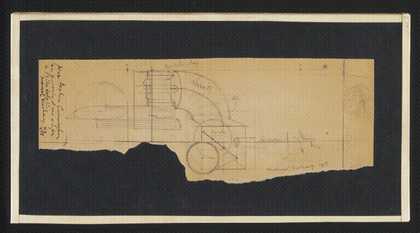
Fig.4
Marcel Duchamp
Untitled 1913
Ink and pencil on paper
Private collection © Succession Marcel Duchamp/ADAGP, Paris and DACS, London 2008
This article focuses on one such note (fig.4) that in 1956 Duchamp gave to a young American television producer named Beatrice Cunningham. Unknown to Duchamp’s family or to Duchamp scholars, this note has been in a private collection in London from the late 1950s. The drawing depicts an element in the lower panel of The Large Glass. It is not claimed that the revelation of this drawing substantially changes understanding of the Large Glass, but it appears to be a ‘missing link’ between some already published notes and deepens our understanding of this central element in the lower panel of the Large Glass.
The Cunningham drawing
The key to the identity of the drawing is provided by the word ‘tamis’, meaning sieves, in the curved cylinder shape in the centre. This links the motif to the Sieves that form an arc of cones in the lower panel of the Glass, the Bachelors’ Domain. According to the narrative explained in the notes, a Gas casts the shape of the Bachelors within the nine Malic Moulds on the left, and then escapes from the Moulds through Capillary Tubes where it is frozen and cut into spangles, and then converted into a semi-solid fog. Sucked through by the Butterfly Pump (not represented in the Glass), the fog then rises through the arc of seven Sieves – cones with holes at their points – and in the process is condensed into a liquid suspension. The liquid falls into a Toboggan (also not represented in the Glass) and ‘crashes’ at its base before being projected upwards to the Oculist Witnesses on the right (see fig.5).
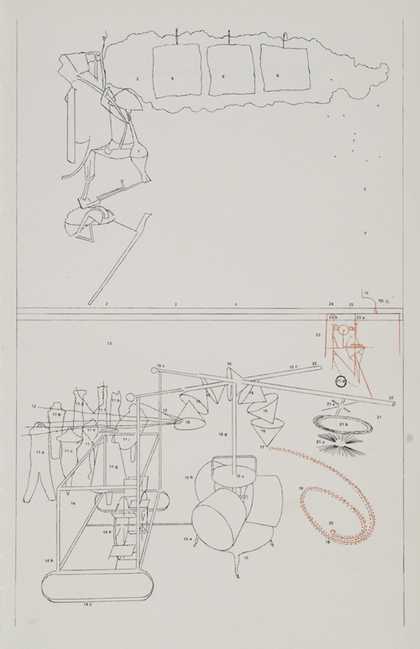
Fig.5
Diagrammatic interpretation of the Large Glass as completed (in Arturo Schwarz ed., Marcel Duchamp: Notes and Projects for The Large Glass, London: Thames and Hudson, 1969, pp.12–13)
The Bride’s Domain (upper half of the Glass):
1. Bride (or Pendu femelle, Virgin, Skeleton). 2. Bride’s Garment. 3. Region of the Gilled Cooler (isolating plates). 4. Horizon. 5. Top Inscription (or Milky Way). 6. Draft Pistons (or Nets). 7. Nine Shots. 8. Region of the Picture of Cast Shadows. 9. Region of the Mirror Image of the Sculpture of Drops. 10. Juggler of Gravity (also called the Trainer, Handler, or Tender of Gravity).
The Bachelor Apparatus (lower half of the Glass):
11. Nine Malic Moulds (or Eros’s Matrix) forming the Cemetery of Uniforms and Liveries. 11a. Cuirassier. 11b. Gendarme. 11d. Department Store Delivery Boy. 11e Bus Boy. 11f. Priest. 11g Undertaker. 11h. Station Master. 11i Policeman. 12. Capillary Tubes. 13. Region of the Waterfall. 14. The Water Mill. 14a. Water Wheel. 14b. Chariot (or Sleigh, or Glider). 14c. Runners Sliding in a Groove. 15. Chocolate Grinder. 15a. Louis XV chassis. 15b Rollers. 15c. Necktie. 15d. Bayonet. 15e. Scissors. 16. Sieves (or Parasols, within are the Drainage Slopes). 17. Region of the Butterfly Pump. 18. Toboggan (or Corkscrew, or Slopes of Flow). 19. Region of the three Crashes (or Splashes). 20. Mobile Weight with nine holes. 21. Oculist Witnesses. 21a, b, c, Oculist Charts. 21d [Mandala] (should have been a magnifying glass to focus the Splashes). 22. Marble. 23. Boxing Match. 23a. First Ram. 23b Second Ram. 24. Region of the Sculpture of Drops. 25. Region of the Wilson-Lincoln effect.
To the left of the Cunningham drawing is a hemisphere, drawn in perspective. It is an unlabelled entity, without any distinguishing characteristics. At first sight, it bears a close resemblance to preliminary studies for the Cravat of the Chocolate Grinder in the lower centre of the panel, or, in other words, the circular flat base and handle above the rollers. Reproduced in the Green Box, Schwarz 259 (fig.6) shows a version of the hemisphere with bisecting lines at its base AC, BD. Similar bisecting lines, which helped Duchamp draw the hemisphere in perspective, can also just be discerned in the Cunningham drawing.

Fig.6
Marcel Duchamp
Note autographe pour “Le grand verre” : la cravate devra son élégance…, 1912-1915
Photograph: CNAC/MNAM, Dist. RMN / © Jacques Faujour © Succession Marcel Duchamp / ADAGP, Paris and DACS, London 2008
![Marcel Duchamp Note autographe pour "Le grand verre" : Triturants et liquéfacteur [n° 1, 2, 3, 4, 5, 6, 7], 1912–68](https://media.tate.org.uk/aztate-prd-ew-dg-wgtail-st1-ctr-data/images/marcel_duchamp_note_autographe_02_0.width-420.jpg)
Fig.7
Marcel Duchamp
Note autographe pour “Le grand verre” : Triturants et liquéfacteur [n° 1, 2, 3, 4, 5, 6, 7], 1912–68
Photograph: CNAC/MNAM, Dist. RMN / © Jacques Faujour © Succession Marcel Duchamp / ADAGP, Paris and DACS, London 2008
![Marcel Duchamp Note autographe pour "Le grand verre" : Triturants et liquéfacteur [n° 1, 2, 3, 4, 5, 6, 7], 1912–68](https://media.tate.org.uk/aztate-prd-ew-dg-wgtail-st1-ctr-data/images/marcel_duchamp_note_autographe_03_0.width-420.jpg)
Fig.8
Marcel Duchamp
Note autographe pour “Le grand verre” : Triturants et liquéfacteur [n° 1, 2, 3, 4, 5, 6, 7], 1912–68
Photograph: CNAC/MNAM, Dist. RMN / © Jacques Faujour © Succession Marcel Duchamp / ADAGP, Paris and DACS, London 2008
Clues to the identity and function of the hemisphere are given in the recto and verso of a note that was published after Duchamp’s death when published in the 1980 volume edited by Paul Matisse. The two sides have been titled by Arturo Schwarz, author of the Duchamp Catalogue Raisonné, Sieves: Triturator and Condenser (Schwarz 296, fig.7) and Sieves: Side View (Schwarz 295, fig.8), and dated 1914 (though Duchamp himself dated, at some point, the related Cunningham drawing 1913, and it seems likely that the resolution of the design of the Sieves was achieved in the earlier year24 ). Together, the recto and verso of this note identify seven elements or processes in the passage of the Illuminating Gas through the Sieves, which are worth quoting in full:
Recto:
Triturators and condenser.. / arrival of the illuminating gas
Triturators: 1. Large Receiver –
2. Distribution (Phenomena / of separation and differentiation / by the form of the capillary tubes)
3. Collectors short tubes: coming together / in 1 first semi / collector. / long tubes: coming together / in a second semi collector / (snail form / or lyre)
4. Mixture bottle – (4 mixture bottles)
Diagram / gas / lg Receiver / capill tubes / long capillary tubes / 1st semi collector / 2nd semi collector / Bottle / toward condenser
Verso:
Condensers
– 5. Sieves - / large gas inlet - / numerous sieve sheets / and with holes more and more / close together, and less/ and less large. / up to the
6. Filter / triangular / in aqueous metal. / Horizontal filter. Leading/ to the churn- (barrel/ shaped/ (curved conical trunk / form with the horizontal / filter for a small base.)
7. exhaust pipe / (before the filter, exhaust pipe / for useless substances / having only served as a vehicle / for the gas -)
Diagram: Sieves / exhaust/ pipe/ horizontal filter
This narrative, which in its terminology mirrors much of the Cunningham drawing, suggests that the hemisphere is a vague, possibly undeveloped, visualisation of the Large Receiver. In the sketchy plan on the recto of the posthumously published note, the Large Receiver is shown as a large circle, a simple container or holding place for the Illuminating Gas – at this stage a ‘fog of solid spangles of frosty gas’25 – before it passed through some capillary tubes to the Sieves.
There is no Large Receiver, however, in the Large Glass. The gas flows from the top of each of the Malic Moulds through the Capillary Tubes to the base of the first Sieve drawn on by the aspiration of the pump. The drawings suggest, however, that, for a while at least, Duchamp toyed with the idea of the gas being kept in a hemispherical receiver from which it was distributed through tubes to the Sieves.
In the Glass the Capillary Tubes are simply the tubes linking the Malic Moulds with the Sieves. As the notes show, however, Duchamp at some point thought of similar tubes leading to the Large Receiver from which there was a second set of tubes leading to a first and then a second Collector. The exact nature of this process is hard to follow, and does not correlate particularly well with the Cunningham drawing in which there appears to be two sets of parallel tubing that twist on a horizontal and then on a vertical axis. The description ‘snail / or lyre form’ in Schwarz 296 may contain the germ of the idea of a curved expression of these tubes. Another note (Matisse 103) talks of the capillary tubes, ‘which by their / length, angle, spread, turnings, transform the gas / into fog. And leave it in the semi-collectors in the state of a dense/ vapour.’26
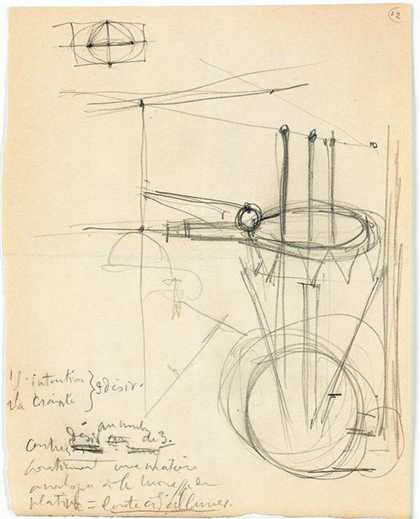
Fig.9
Marcel Duchamp
Note autographe pour “Le grand verre” : 1 l’intention, 2 la crainte, 3 le désir, 1912–68
Photograph: CNAC/MNAM, Dist. RMN / © Jacques Faujour © Succession Marcel Duchamp / ADAGP, Paris and DACS, London 2008
The fourth stage listed in Schwarz 296 is ‘mixing bottles’, exactly the same phrase used in the Cunningham note to describe not bottles but three pointed forms that line up exactly with the mouth of the Sieves cylinder. A key to understanding the identity of these forms lies in another note that was also first published in 1980 (Schwarz 319, fig.9). This shows three arrow-like forms entering a circular form. In the correct orientation, these arrows hang down from a part of the Scissors above the Sieves, but, seen from the side, they resemble closely the horizontal arrow shapes in the Cunningham drawing. The text identifies each of these three shapes as ‘desire centres’:
1 intention / 2 fear /3 desire
Desire centres, 3 in number. / Contain a material / analogous to platinum / sponge = slow to light.
For Schwarz, these words illuminate the emotional drama of the Bachelors: their intention to meet the Bride is countered by the fear of the consequences, which in turn is overcome by the strength of their desire. A second note (Matisse 161, recto) echoed these themes in referring to a ‘desire dynamo’, with ‘positive rods’, which were ‘three in number’ (‘intention-state’, ‘scruple’, ‘desire-action’) and terminated with a ‘positive sponge’. (The idea of metal sponge was an invention of Duchamp. Suggestive of a porous filter – something that impeded the flow of a liquid or gas but would eventually let some or all of the substance through, it was an idea that reappeared later in the guise of the Sieves.) It is not possible to be clear that the three-pronged ‘mixture bottles’ are also these ‘desire centres’, but there is a resemblance between the ways the two motifs are depicted, which suggests that for a period the two concepts were linked – at least on the level of visualisation - in Duchamp’s mind. It should be noted that in an early note offering a ‘breakdown’ of the parts of the Bachelor machine (Matisse 98), Duchamp listed ‘3. Tubes of erotic concentration / (intake of the illuminating gas: / principle of the erotic liquid. / Whistle’, and ‘4. Desire dynamo – / combustion chambers / Desire centres / Sources of the stripping.’ This would suggest that at an early stage of thinking about the production and movement of the ejaculatory (?) fluid through the system he saw the tubes as closely linked with desire centres set within a combustion chamber. This was what Duchamp described simply in one note (Matisse 131) as the ‘Hot chamber of the triple decision’, before later adding the words ‘To Omit’. The apparatus in the Cunningham drawing appears to have been a somewhat later development of this early concept of a desire dynamo set within a hot chamber.
The fifth element in the journey of the Gas is the passage through the Sieves themselves. A simple short note described the Sieves and horizontal filter as ‘progress (improvement)’ in the passage of the gas to the Slopes of Flow, indicating that the idea of the Sieves came later in the development of the plan for the Bachelors’ Domain.27 According to the notes published in the Green Box, the Sieves were initially conceived as seven parasols. The first traps the gas which rises through the hole at the top to the next. Sucked on by the Butterfly Pump, the gas passes through all seven Sieves.
This process makes the spangles – now conceived of as quasi sentient entities – lose all sense of awareness of direction and their individual position, and they join together to form a suspension. A note (Matisse 133) refers to the cones as resembling udders, made of ‘elastic metal’, allowing the ‘erotic liquid’ to pass drop by drop towards the ‘hot chamber, onto the planes of slow flow’. In the same note he described the erotic liquid as having a ‘cream like molecular cohesion’, and added in pencil as an afterthought the words ‘la rosée d’Eros’, or dew of Eros – a palindromic play that anticipates the name of Duchamp’s female alter ego, Rrose Sélavy, launched into the art world in 1920 as the author of the object Fresh Widow (See Tate T07282).
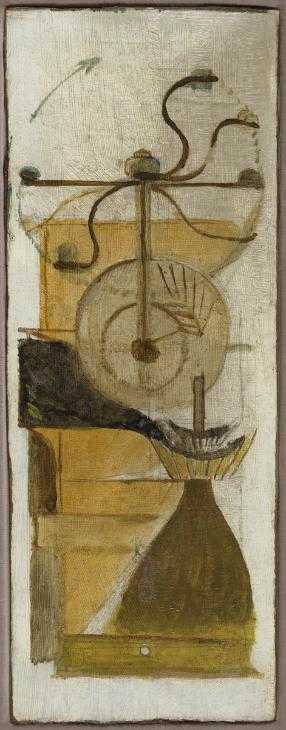
Marcel Duchamp
Coffee Mill (1911)
Tate
© Succession Marcel Duchamp/ADAGP, Paris and DACS, London 2025
The Sieves in the Cunningham note correspond exactly to those depicted in Schwarz 295 (fig.8). The Sieves are not yet conceived of as parasols or cones, but rather as circular filters within a cylinder. In Schwarz 295 there are significantly seven such filters before the separately indicated last ‘Horizontal Filter’, suggesting that Duchamp retained at least the idea of seven-ness when he abandoned stages 1–4 and chose the simpler, more graphic solution of an arc of cones (reminiscent in his mind of the overlapping nature of ‘roofing tiles’ or ‘fish scales’28 ) in the Large Glass.
After the seventh filter and before the base filter there was in both Schwarz 295 and the Cunningham drawing an upward pointing arrow. As Schwarz 295 reveals (and is confirmed in Matisse 133), this was an ‘exhaust pipe’, for ‘useless substances / having only served as a vehicle / for the gas’. Duchamp had first introduced an arrow into his work in the small painting Coffee Mill 1911 (See Tate T03253) (fig.10), saying later that the innovation had pleased him: ‘the diagrammatic aspect was interesting from an aesthetic point of view.’29
Through the base filter the liquid suspension containing the transformed spangles enters the Churn (‘Baratte’). Quite what makes the Churn turn is unclear: it seems to involve a toothed cog wheel which somehow drives a circular or spherical drum set within a cube. This element appears to be a variant of that shown in Schwarz 301/Matisse 125 (fig.11), a much less carefully drawn but more easily understood picture of the mechanism. Here a circular Churn is driven by a belt that goes around a toothed cogwheel that in turn revolves on an axle. Attached to the Churn is a suction pump which leads onto a cube-shaped Compressor (in the Cunningham drawing, the Churn, the cogwheel, the pump and the Compressor are contained within the same space, rather than presented sequentially as in Schwarz 301/Matisse 125. In another note (Matisse 133) Duchamp had toyed with conceiving of these elements as arranged on different planes, moving from the Churn, to the filter, to the capillary tubes and finally to the Large Receiver in the furthest plane, but then crossed this list out, showing that he rejected this way of visualising this arrangement of the elements in three-dimensional space.
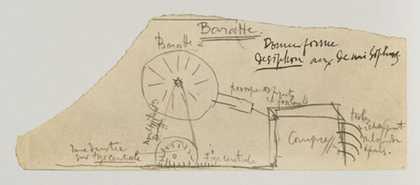
Fig.11
Marcel Duchamp
Note autographe pour “Le grand verre” : Baratte, 1912–68
Photograph: CNAC/MNAM, Dist. RMN / © Jean-Claude Planchet © Succession Marcel Duchamp / ADAGP, Paris and DACS, London 2008
Finally, on the right of the Cunningham drawing is an arrow and the words ‘dynamo désir’, already discussed in relation to the arrow-like rods and the note ‘Intention, Fear, Desire’ (Schwarz 319 / Matisse 163, fig.9). It may be that Duchamp first developed the visual form of the three rods in the Cunningham drawing, and later re-used the forms for the desire dynamo theme of Schwarz 319. At some point – it is not clear when – Duchamp signed and dated the Cunningham note ‘1913’.
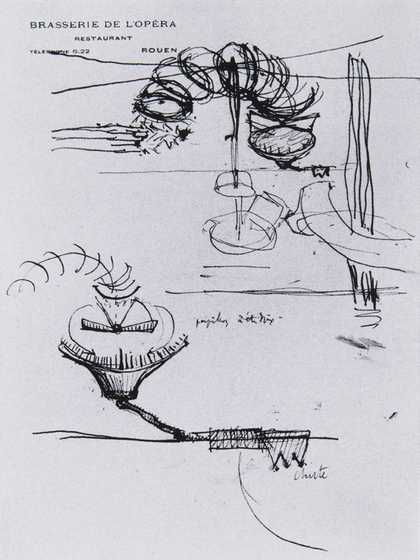
Fig.12
Marcel Duchamp
Sieves and Detail of the Butterfly Pump 1914
Ink on letter paper from the Brasserie de l’Opéra, Rouen
27.5 x 19.3 cm
Collection Dina Vierny, Paris © Succession Marcel Duchamp/ADAGP, Paris and DACS, London 2008 [Schwarz 293]
At some point in 1913 it appears that Duchamp abandoned the idea of a desire dynamo, along with the entire apparatus shown in the Cunningham note. As recorded in Schwarz 293 (fig.12) and 295/Matisse 114 (fig.8), Duchamp came to envisage the sieves as an arc of dome-like forms, leading into a pump, before adopting the final version of an arc of conic shapes, as shown in Schwarz 302. Quite how the gas entered or how it came to pass through the arc is not spelled out in the final work, though, as has been seen, he had had several ideas about this. Various other ideas about how to represent what happened to the liquid thereafter were also abandoned by Duchamp in the Glass.30
For Richard Hamilton, the apparatus in the Cunningham, in relation to the final work, was a ‘bit of a dinosaur’: ‘it is too clumsy and a much more elegant solution had evolved.’ He explains:
The triturator device … is intended to pulverise and sieve the spangles of solidified gas when it has left the capillary tubes. His much simpler resolution to the problem is that the lighting gas breaks into needles and the needles rise into the sieves because the (given) lighting gas is, as Marcel reminds us, lighter than air. The path over the sieves to the splash is, in my opinion, the result of his abandoning trituration and condensers and taking another look at his coffee grinder painting, dated 1912 and also a pulverising machine (fig.13) … I confess that when I pointed this out to Marcel at the time I was writing captions for the Sisler catalogue he was not over impressed by my theory. I still believe I was right, why else would a reproduction of the coffee grinder be featured in the Green Box, plus a drawing that is even more convincing evidence, while all the trituration stuff was filtered out?31
The gift to Beatrice Cunningham
In late 1955 Duchamp agreed to be interviewed for a television series ‘Conversations with Elder Wisemen’, broadcast by NBC early in the following year. He travelled from New York to the Philadelphia Museum of Art which housed the biggest collection of his works through the donation of the Walter Arensberg collection, as well as the Large Glass. His interviewer was James Johnson Sweeney, director of the Solomon R. Guggenheim Museum, New York, who knew him well and had already interviewed him some years earlier.32 Duchamp stood in front of his works, and talked directly about them to Sweeney.
Later a book was made of the interviews. At first it was thought that the session with Duchamp ‘seemed like television – mostly pictures, and not for a book’, but then the decision was made to include it: ‘his conversation was too stimulating and droll, and his convictions not too honest, to omit’.33 In this way Duchamp’s discussion of his works came to be produced in a book wonderfully titled Wisdom: Conversations with the Elder Wise Men of our Day. As the published text shows, the interview focused a great deal on the Large Glass which dominated the room of his works in which the interview was staged. Duchamp felt very much at home and happy in this environment: ‘I have always felt that showing one painting in one place and another in another place is just like amputating one finger each time, or a leg. Here I feel at home. This is my house. I have never had such a feeling of complete satisfaction.’34
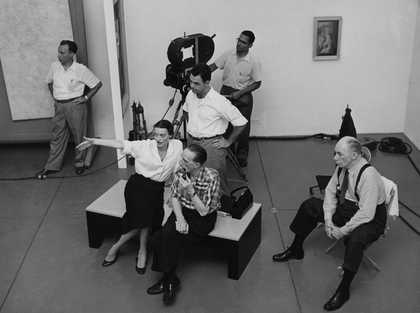
Fig.13
Marcel Duchamp in conversation with Beatrice Cunningham in the Philadelphia Museum of Art 1955
Photograph
© Archives of the Philadelphia Mueum of Art
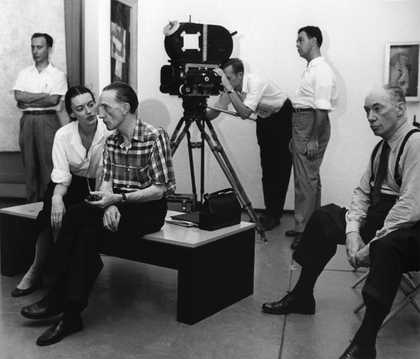
Fig.14
Marcel Duchamp in conversation with Beatrice Cunningham in the Philadelphia Museum of Art 1955
Photograph
© Archives of the Philadelphia Mueum of Art
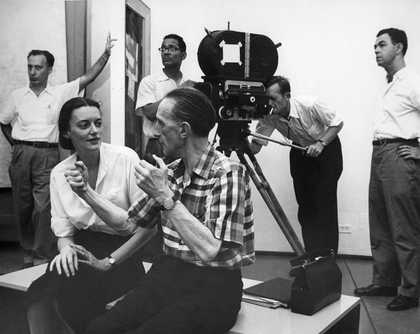
Fig.15
Marcel Duchamp in conversation with Beatrice Cunningham in the Philadelphia Museum of Art 1955
Photograph
© Archives of the Philadelphia Mueum of Art
Photographs taken of Duchamp with the television crew show that a key person in the making of the programme was the Associate Producer Beatrice Cunningham (1923–1989) (figs.13–15). While James Johnson Sweeney sits to one side, she and Duchamp are shown sitting close to each other, engrossed in conversation. Nothing is known about what they talked about but it would seem likely that Duchamp spent time discussing the Large Glass with her.
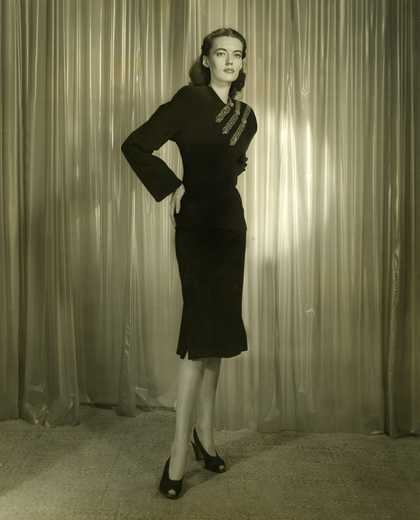
Fig.16
Beatrice Cunningham as a model
Photograph
Private collection © Walter Arensberg Collection
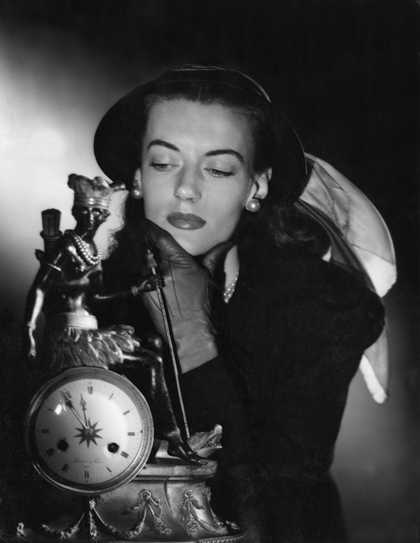
Fig.17
Beatrice Cunningham as a model
Photograph
Private collection © Walter Arensberg Collection
A striking woman, Cunningham was a former fashion model for Vogue (figs.16–17). At a time when there were few women at senior levels within television, Cunningham worked as an Associate Producer on the Wisdom series from 1954–8, filming not only Duchamp but also Eleanor Roosevelt, Jawaharlal Nehru, David Ben-Gurion, Igor Stravinsky and Pablo Picasso. In the same year she also completed a challenging assignment, filming near Djarkata, Indonesia, in which the film crew had needed an armed police escort. It was while there that she met her future husband, Wolf Suschitzky, a key figure in the British documentary film movement and a photographer.35
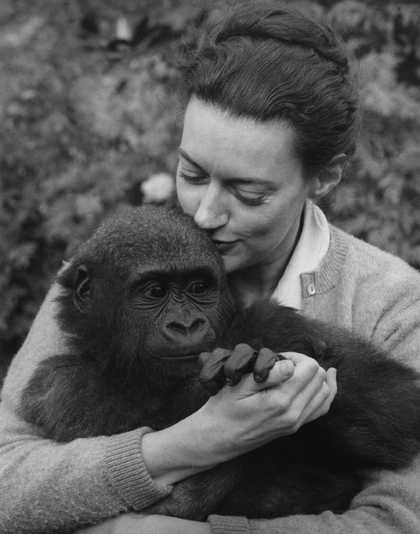
Fig.18
Wolf Suschitzky
Beatrice with ape
Photograph
Private collection © Walter Arensberg Collection
Very little is known about why Duchamp chose to give a note relating to the Large Glass to Cunningham, sealed under a pane of glass attached simply with sticky tape to a back board. Wolf Suschitzky recalls:
I was told by my late wife that after the interview in Philadelphia, a few days later, there was a ring at her door and he stood there with this gift […] I doubt if they saw each other much after their return to N.Y. Anyway, Beatrice did not mention it to me. She seemed to have been surprised to see him with his gift.36
The inscription in French – ‘en souvenir d’un enfer à Philadelphie’ or ‘in memory of hell in Philadelphia’ – might have referred to the ‘hellish’ experience of making the programme or more specifically to the difficulties of working under hot camera lights for two days. Curiously, Beatrice did not speak French, but, although fluent in English, Duchamp preferred here to express this idea mellifluously in his native tongue.
It is not clear why Duchamp would have selected this particular note from the many he had in his possession to give to Cunningham. Certainly, during the interview itself, he had stressed the importance to him of the dry, mechanical style of drawing he had adopted in 1913:
I wanted to go back into a completely dry drawing, to a dry conception of art. The mechanical drawing, for me, was the best form of that dry form of art. Accuracy, precision – nothing more […] All the glass was imagined and was drawn in 1913 and 1914, on paper. It was based on a perspective view, meaning complete control of the placement of things. It couldn’t be haphazard or changed afterwards.37
It may be that it was in fact the best note he then had in his possession to illustrate the importance of mechanical drawing in relation to a motif in the Large Glass. The notes published in 1966 in à l’infinitif and after his death in 1980 did not include anything comparable: most were written notes, with only occasional and sketchily drawn visual notations. It might also be that the perspiration-inducing heat of the television lights and the proximity of the beautiful Beatrice Cunningham conjured a parallel in his mind with his vision of the Bachelors’ liquid or ‘dew of Eros’ dripping through the cones into a ‘hot chamber’.
Duchamp both cared fanatically about his notes for the Large Glass, as shown in his painstaking reproduction of them in facsimile form, and was happy for some to remain unknown in folders among his papers or even, as with the Cunningham drawing, to be potentially lost from sight for many years, possibly forever. In this latter case, it was the act of giving a token of friendship or of admiration to a particularly beautiful and intelligent woman that mattered.
Some notes were clearly less important than others; the fact that the Cunningham drawing depicted an abandoned way of visualising the passage of the Gas through the Sieves may well explain why it had not been included in the Green Box. The story of the Cunningham gift, however, points to the role that Duchamp played in selecting some notes for publication and allowing others to remain unknown, even lost from sight. The torn edges of the Cunningham note suggest, too, that even as he prepared the work as a gift, he perhaps tore the drawing away from a larger piece of paper, removing something that he did not want to be seen by others. What we know about the notes – for all the editions and subsequent publications about them – may be more partial and pre-edited by Duchamp than we have thought. But this does not alter the fundamental challenge to our understanding posed by the notes that was first expressed poetically and aptly by André Breton writing in 1934:
Future generations can do no less than make a systematic effort to go back up the stream of Duchamp’s thought and carefully describe its meanderings in search of the hidden treasure which was his mind, and through that mind what is rarer still and even more precious the very spirit of his period. What is at stake here is a profound initiation into the most modern way of feeling, where humour presents itself as the implicit condition of the work.38

